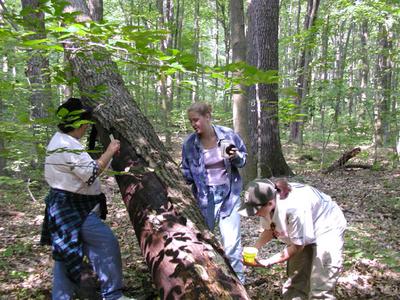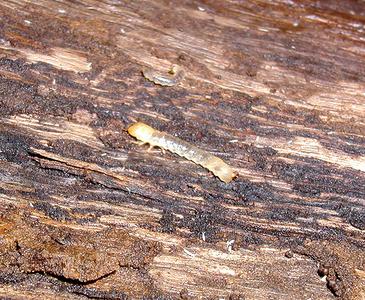20 June, 2002
6/20/02
Collecting in the summer.
Considering the nature of the lab work here at Notre Dame, I am going to post
entries every other day rather than post daily. I think I can discuss the lab
experience very well with slightly fewer entries.
This morning everyone arrived in the lab a little earlier to prepare for a
summer larvae collection trip. We drove to a forested area just north of
South Bend to look for a summer sample of Cucujus beetle larvae. Collecting
in the summer in Indiana is certainly a different experience than collecting
on the tundra in Alaska. Our major practical concern was getting out early
enough that it would not be to hot and humid for us to be out in the woods.
We also got to deal with buzzing, biting insects. I am amazed at how many
flies, gnats and other assorted pests a hot, sweaty person can draw in the
forest. We seemed to constantly be swatting at something. Given a choice, I
think I prefer collecting at Toolik.
During this morning's trip, I was also introduced to a species of beetle
found commonly here in the Midwest, but not found in Alaska. The beetle,
Dendroides, is similar in appearance to Cucujus and has been studied
extensively by Dr. Duman's lab here at Notre Dame. They also appear to be far
more numerous in this area than the Cucujus beetles. In nearly everywhere we
looked, we seemed to find Dendroides in numbers far higher than Cucujus. The
collection process is still pretty much the same. Find a fallen tree in the
right state of decay and peel away the bark. The larvae live just under the
bark.
In just a few hours, we had collected a reasonable number of Cucujus larvae
and a very large number of Dendroides larvae. Most of these larvae will be
used for DNA and protein studies later in the summer.
Upon returning to the lab, I continued working on some new super-cooling
techniques for the lab. Super-cooling is placing the larvae into a tube,
which is then placed into a bath and allowed to chill to temperatures well
below zero. The point at which the larvae actually freeze is measured and
recorded as its super-cooling point. By attempting to alter some of the
procedures, we are trying to address an anomaly that we are seeing in the
data. Our Cucujus samples seem to be super-cooling at very different
temperatures. It would seem likely that individuals from the same population
and location would have similar adaptations to their environment. In the case
of our larvae, we should expect them to have very similar freezing
characteristics. Our data however, is showing that we have distinct
differences in the Cucujus population. Most of the larvae have super-cooling
(freezing) points near -350C, but yet a significant number of our test larvae
have had super-cooling points above -100C. This bi-modal spread in the
population is very unusual and very interesting to everyone here in the lab.
Before getting too excited however, we must make sure that the result is not
due to some problem in our freezing techniques.
Consequently, Dr. Valerie Bennett and I have been trying to devise ways to
make the lab procedures as similar as possible to the conditions the larvae
would actually see in the logs. Part of my task over the next week and a half
will be to test several of our new techniques for their effectiveness and
compare the results to those we have seen using the established procedures.
Hopefully, I will have contributed something useful to the lab by the time I
leave here next week.

Dr. Val Duman, Sandy Sass and grad student Jessie Nicodemus looking for larvae in a decaying log.

Val and Jessie searching under the bark.

The Dendroides beetle larvae found in Indiana.
Contact the TEA in the field at
.
If you cannot connect through your browser, copy the
TEA's e-mail address in the "To:" line of
your favorite e-mail package.
|
